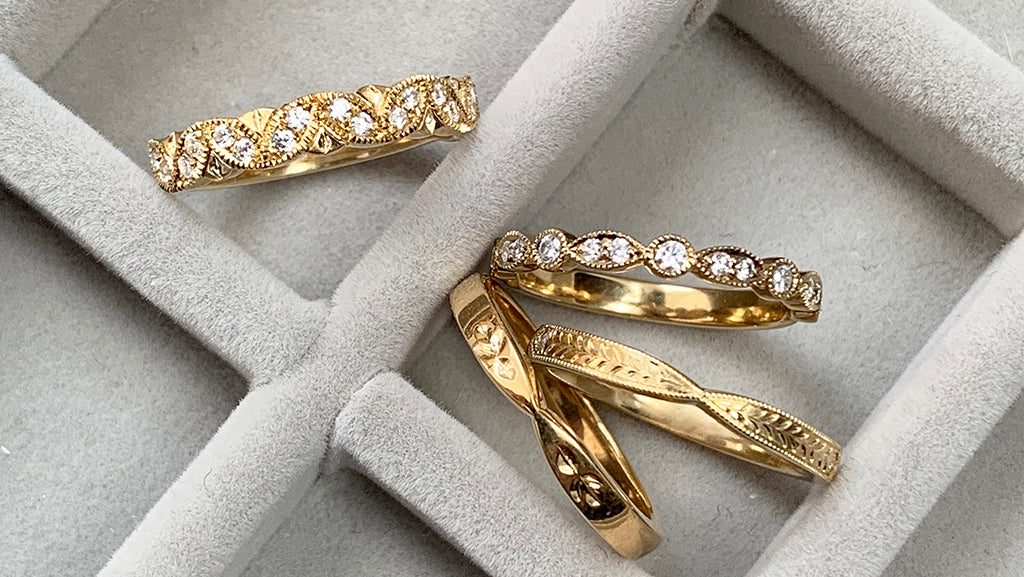Your Cart is Empty

Engraved jewellery has a rich history which dates back thousands of years to Ancient civilisations, when Egyptians, Greeks and Romans used chisels and small hammers to carve intricate motifs and symbols into metal. During the Middle Ages, engraved jewellery was particularly popular amongst nobility and the clergy, with skilled engravers commissioned to carve religious motifs, family crests and heraldic symbols onto rings and pendants. It was during this period in time that the burin, a type of chisel with a sharp wedge-shaped tip, was developed and favoured.
The Renaissance period saw a surge of interest in intaglios and cameos, intricate designs scored into precious gemstones. These designs were largely achieved using gravers, sharp tools not dissimilar to burins, but with rounded ends used primarily for cutting shallow lines and removing small amounts of material; perfect for creating fine details. As the art of hand engraving gained prominence, dedicated schools and guilds emerged to train and support engravers, providing education, apprenticeships and a platform to share techniques and artistic styles.
The Art Nouveau and Art Deco movements of the late 19th and early 20th centuries ushered new ideas into the realm of jewellery. Whilst Art Nouveau embraced flowing, organic motifs inspired by nature – much like our signature Scrolls and Vines patterns - Art Deco introduced geometric shapes and bold, linear patterns. The latter were often engraved into metal using emerging power-assisted tools.
The advent of modern techniques like laser engraving and computer-aided design (CAD) suddenly facilitated quick, detailed and customisable engravings on various materials, making engraved jewellery more accessible for all. Despite this availability of contemporary tools, however, traditional hand engraving techniques – like those employed by our master craftsman Darren – remain valued for their skill and artisanal qualities.

Though the polished gleam and quiet timelessness of a plain wedding band appeals to some, intricate patterns lend themselves better to the personal styles of others. At Lebrusan Studio, we’re regularly approached by jewellery shoppers who wish to mark their milestone with a wedding ring that will toy with the light and draw admirers in for a closer look.
Our Vines motif is as florid and organic as it is understated, whilst our Cedar design is a more intricate interpretation of Mother Nature’s gifts, incorporating greater detail and a smattering of small diamonds throughout.

Our new Orange Blossom design is a further celebration of the great outdoors. A promise of bountiful fruit, the orange blossom is a symbol of optimism and prosperity; a befitting celebration of your new chapter. Catapulted into prominence when a young Queen Victoria adorned her wedding crown with the five-petalled citrus bud - forecasting a fruitful marriage at a time when flowers did so much of the talking - the orange blossom was later reimagined as a popular hand-engraved motif during the Art Deco period.

A muted and more geometric abstraction of flora, our angular Wheat Sheaf design is perfect for those who find comfort in symmetry and order.

Derived from ‘mille-grain’, which is French for ‘a thousand grains’, milgrain is a decorative accent of tiny beads, usually applied in neat rows to borders of bands or gemstone settings. This timeless finish can be found skirting the edges of our Vintage Milgrain wedding bands, our sweet Heart designs and our new Amare collection, all of which embody the curious charm of the antique jewellery we see sparkling in the windows of second-hand jewellers, inspiring us as we pass.

Then, there’s our signature Scrolls design; the sweeping, light-refracting texture that draws curious wedding shoppers in our direction time and time again.
The iconic scroll motif boasts a rich and interesting history; from the Renaissance period seeing engraved scrollwork become a common feature of armour and firearms to demonstrate wealth and sophistication, to the favouring of floral motifs and curvilinear shapes during the Art Nouveau era, which placed great emphasis on craftsmanship and the natural world.
Though our intricate ‘Wriggle Scrolls’ variation was initially designed with the slender 2mm band in mind and its deeper, more sweeping ‘Cut Scrolls’ counterpart conceived for the wider band, recent commissions have taught us that either style can be beautifully transferred to a band of any width, thanks to the ability of our hand-engraver Darren to sympathise cleverly with any given surface.

Though the intricate ‘Wriggle Scrolls’ variation was initially designed with the slender 2mm band in mind and its deeper, more sweeping ‘Cut Scrolls’ counterpart conceived for the wider band, recent commissions have taught us that either style can be beautifully transferred to a band of any width, thanks to the ability of our hand-engraver Darren to sympathise cleverly with any given surface.


Intended for one set of eyes only, private messages and emblems engraved on the inside of a band are incredibly romantic. If you’re unsure about wearing a wedding ring that says too much from an outsider perspective, internal detailing is a clever way for you to ensure your ring feels like no other – for your benefit. Important dates, geographic coordinates, beloveds’ names and snippets of song lyrics are popular choices.
Our short inner-band engravings (15 characters or less) cost an additional £50 per ring, whilst longer inner-band engravings (more than 15 characters) cost £80.

Laser engraving uses a highly concentrated laser beam, the thickness of which affects the thickness of the engraving itself. Either freehand or attached to a machine, it works similarly to how a pencil moves across paper. This technology grants the modern-day couple access to progressively inventive design; from bespoke logos to song soundwaves and even electrocardiographs.
Though we prefer to champion the knowledge and skills of artisans like Darren – ensuring that cultural heritage may be passed down from one generation to the next – we are by no means closed off to the wonders of modern technology. We recently explored the pros and cons of hand-engraving vs. laser-engraving; you can read the blog post here.
